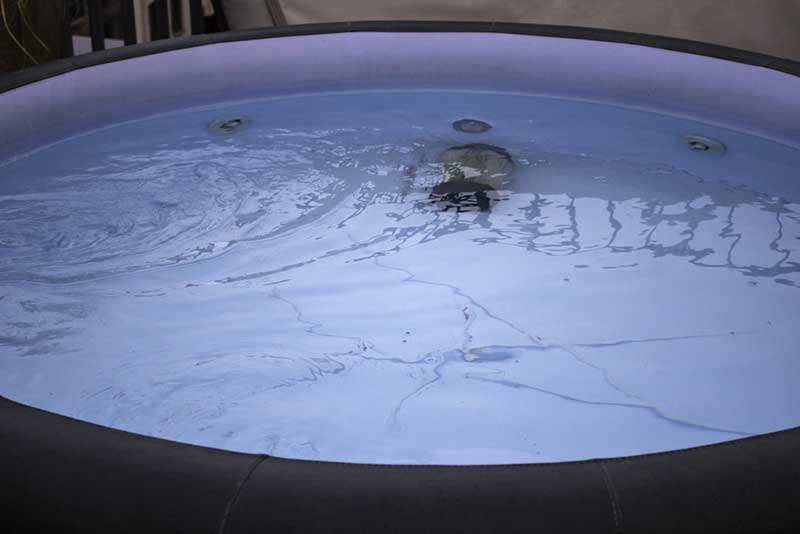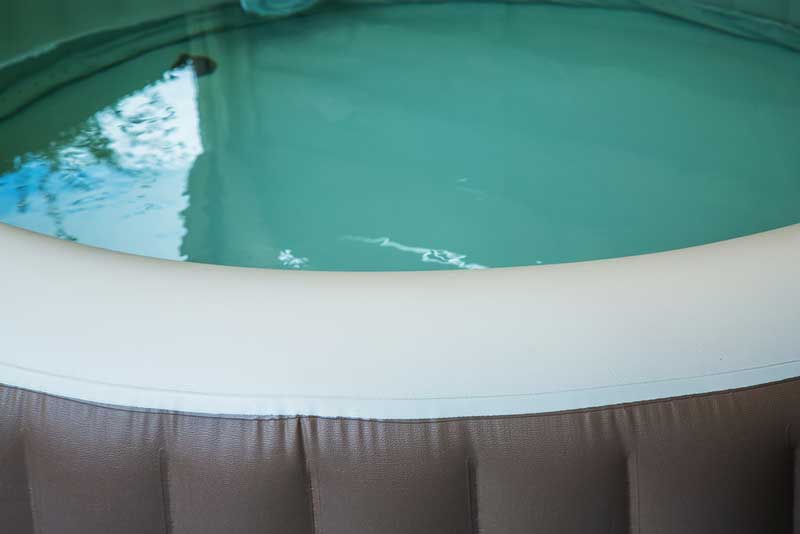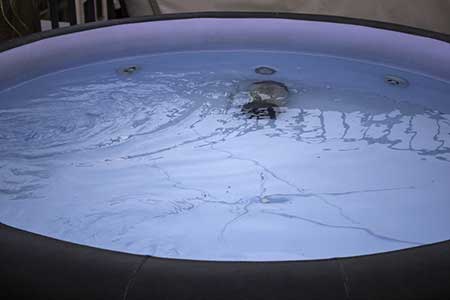
Have you ever got into your inflatable hot tub and noticed that it has gone a bit slimy? This is an unpleasant but common problem and luckily a slimy hot tub can easily be avoided with a few basic maintenance tasks. In this post, we look a what causes slime in hot tubs and how to avoid it.
So, how do you stop an inflatable hot tub going slimy? You can prevent an inflatable hot tub going slimy by making sure the water pH level is balanced, regularly shocking and sanitizing the water, keeping the filter clean, and periodically draining out and cleaning the tub. It’s also important to prevent debris from getting in by covering the tub whenever it isn’t in use. An additional enzyme-based disinfectant product may also be added regularly to the tub to guard against biofilm build up.
If you’ve invested in an inflatable hot tub, you’re sure to want to get as much use as possible from it. It’s difficult to do this, though, if you find that the sides and bottom of your hot tub is covered in an unpleasant slimy substance.
This slime is actually biofilm which can form on the surfaces of your hot tub and which can seriously put a crimp in your hot tub enjoyment. On the upside, though, there are a number of things you can do that will get rid of slime in your hot tub and prevent it from happening again.
What Causes Slime In A Hot Tub?
Slime, or biofilm, inside your hot tub will typically be caused as a result of microorganisms and bacteria that naturally grow inside the piping or interior of the hot tub accumulating over time. The slime may eventually cause the water to become cloudy, but in a worst case scenario, it can cause a scum-like, unpleasant-smelling substance which will float in the water.
It’s unfortunate but true that the hot tub environment is the perfect one in which biofilm will grow since it is generally moist, warm and dark.
A hot tub that hasn’t been properly disinfected and maintained will have an even greater chance of experiencing biofilm growth. Mostly, biofilm comes from chemicals that are found either on or in the bodies of the people who bathe in the tub.
These chemicals may include deodorants, skin oils, perfumes, lotions or hair products. Filters that are old or damaged, water that is imbalanced, and sanitation that is ineffective also all lead to slime forming on the surfaces of a hot tub.
If too much slime is allowed to accumulate, sanitisers like chlorine or brome will be less effective. Not only that, but it will also start to clog up the spa’s piping and harbour colonies of bacteria. Once biofilm begins to take hold it’s extremely hard to eradicate, so you need to prevent it from occurring in the first place.
Since biofilm can harm human health if allowed to build up, not to mention causing damage to the hot tub itself, it’s very important to make sure that it is treated as quickly as possible otherwise more problems will occur and it will become even harder to remove.

Biofilm – What Actually Is It?
Biofilm is, essentially, a layer that is composed of bacteria, bacterial secretions and the waste products that it produces. It builds up on all surfaces which are exposed, even for a short while, to water, and it contains nutrients which support bacterial life.
Bacteria consumes sulphates, iron compounds, dead microorganisms and organic matter like sloughed-off skin (which is often found in hot tubs). It then creates a sticky substance so it can attach itself to surfaces.
When bacteria comes together with its byproducts and the sticky proteins and polysaccharides that it produces, it makes a biofilm. Once a biofilm has formed, bacteria is unable to leave its surface, and once new bacteria has been produced it will stay inside the biofilm.
Biofilm is the way in which bacteria protects itself from cleaning products and chemicals. It has a slimy texture, and although not everything that is called slime is biofilm, in a hot tub any slime that you encounter on its surfaces is almost certainly going to be biofilm.
How Can I Get Rid Of Slime In My Hot Tub?
If you’ve discovered unwanted slimy biofilm on the surfaces of your hot tub, you may think that you can easily remove it by just wiping it off. However, it isn’t as easy as that. Visible slime around the waterline can be wiped away quite easily, but that doesn’t mean that the problem is gone.
There will be slime on the surfaces beneath the water too. Even draining your hot tub and cleaning all of its surfaces with disinfectant wipes still won’t resolve the issue since there will almost certainly be biofilm remaining inside the inner workings of your tub.
Therefore, you need to make sure that everything has been properly flushed out and sanitized so you can be confident that they have been cleared of all bacteria.
The best course of action to take is a four step approach.
Clean the hot tub – First, clean all of the elements of the hot tub, piece by piece. Make sure that you’ve removed and changed the filter, cleaned out the skimmer and the cover (both the upper and lower side), and thoroughly wiped down all areas of the tub that aren’t submerged in water. It’s vital to use a strong sanitiser as this will prevent any residual bacteria from remaining behind.
Shock the hot tub – Once you’ve cleaned the tub, the next step is to shock the water. This will kill any microorganisms and bacteria that are in the water. You will need to take an extreme approach to the shocking process, using 4 times the typical amount you’d use if you were normally shocking the tub’s water.
Switch the jets on and allow the spa to continue running for around one hour, keeping it covered the whole time. This will help to make sure that all of the chemicals have pervaded through the entire interior workings of the hot tub, killing all of the unwanted bacteria within it.
Flush the system – Now, it’s time to flush the system. Once the shocking process is finished, you should drain out all the water from the tub, removing the bacteria that has built up in the interior workings. Use an all-surface cleaning solution to scrub the empty tub interior down well.
Take the time to clean all parts of the tub, especially the floor area. You need to ensure that your tub is as clean as possible to prevent the slime from growing back. Once you’re confident that the process is finished, you can then fill the tub back up with water.
Can Hot Tub Biofilm Be Prevented?
Going through the above process to remove biofilm from your hot tub can be a major pain, and it’s something that you’ll want to avoid doing on a very regular basis. Therefore, the best course of action is to avoid allowing biofilm to develop and accumulate on your hot tub in the first place. This can be done by carrying out regular maintenance, sanitising and cleaning of the spa.
Some of the steps that you should take include:
- Balancing the water – make sure that you test the tub’s water once per week to check its alkalinity level and pH balance. You should be aiming for a pH level of between 7.2 and 7.4. If the level is below this, it will be too alkaline and this will reduce how effective the sanitiser is while also causing cloudiness in the water. If the level is higher that this, the water will be too acidic and this will corrode the hardware and cause irritation to the eyes and skin of bathers. When it comes to alkalinity, you need to have 60 – 120 parts per million (ppm). Higher levels are going to result in scaling and cloudiness. Add some sanitiser, then test once more to check that the water has been properly balanced.
- Shocking the water weekly – if you shock the water once per week with sanitiser, this will stop microorganisms and bacteria from accumulating. This will ensure the residual sanitiser is more effective.
- Rinsing the filter – having a clean filter is important to protect against bacteria, algae, biofilm and any other potential harmful contaminants. You should rinse your filter out once per week with water, then once per month, use a chemical rinse to give it an even deeper clean.
- Covering the tub – you should always cover your hot tub when you’re not using it. Not only will it stop the heat from escaping and help to keep your energy bills down but it will also stop rainwater, animals and debris from getting in the water so it will be clearer and cleaner for much longer.
- Periodic draining and cleaning – if you drain and clean your hot tub’s interior once every couple of months, this will help to guard against the build up of chemicals and other issues that may arise if you go too long between cleanings. Performance issues can also be prevented that could otherwise necessitate costly repairs to put right.
- Using supplementary disinfectants – enzyme cleaning products and supplementary sanitisation products can help to keep the tub’s water fresh, clear and clean. These products help to also protect against parasites that are resistant to chlorine which is in typical hot tub sanitisers.
Unfortunately, biofilm will sometimes build up in your hot tub regardless of how often you maintain it and clean it. So long as you regularly carry out routine maintenance and sanitise the tub adequately, any issues you experience with biofilm should be minor, however.

Can Slime In My Hot Tub Be Caused By Algae?
Generally, algae forms in hot tubs if the water’s pH level isn’t properly balanced, or if insufficient sanitisation chemicals like chlorine or bromine have been put into the water. Mildew and mould may look like white, floating slime in the tub’s water, or it may form discoloured patches of black or white on the shell of the hot tub.
This is a different type of slime to that caused by biofilm, but it is no less unpleasant and still needs to be treated and removed.
Mildew, mould and algae are all different organic substances but none of them belong in your tub. When algae is in a hot tub, it may appear to be several colours – yellow, green, black or white. Often, when algae is present, the water will look cloudy or greenish and the sides of the tub may feel slippery to touch.
Algae usually forms if the water’s pH level is imbalanced or if insufficient chlorine or brome has been added. Algae flourishes in sunlight, so if your tub remains uncovered for any length of time, algae growth will be worse.
Mildew and mould, meanwhile, may look like white, floating slime in the water, or patches of black or white on the tub’s sides. While mildew can be wiped away quite easily, mould is harder to get rid of and may have been caused as a result of lotions or soaps that got into the water from bathers’ skin. It often gets into the jets, plumbing or filters, but then starts to grow. It may also appear first on the cover of the hot tub, but then get into the water.
Often, minor mildew, mould or algae problems can be resolved by adjusting the water’s pH level and shocking the tub. However, it’s best to drain the tub following shocking and cleaning it with a water and baking soda mixture. Clean the filters and replace them before you refill the tub.
If the contamination is extreme, you’ll need to shock the water once again after you refill the tub, then drain it, clean it and refill it once more. Although this is time-consuming, it will eradicate the contaminants and restore the water to a clean and hygienic condition.
You can prevent the formation of mildew, mould and algae in your hot tub by keeping it covered if you’re not using it, keeping all the filters clean and replacing them regularly, and following the tub manufacturer’s instructions regarding maintenance.
Related Questions
How do I sanitise a hot tub? You will need to sanitise your hot tub regularly to control the built up of bacteria and prevent it from growing.
Bacteria multiplies quickly in the warm, moist environment of a hot tub, so you have to keep the sanitiser level correct to kill microorganisms in the water. You can use either chlorine or bromine to sanitise your tub.
Chlorine is usually the first choice since it is good value and rapid-acting. It comes in both tablet and granule form. Granules can either be sprinkled over the surface of the water or pre-diluted in warm water. Chlorine tablets, meanwhile, need to be put into a dispenser and allowed to slowly dissolve into the water.
Bromine is slower acting and more costly, but its smell isn’t as strong and it can regenerate so you need to add a lower amount of sanitiser. Bromine tablets and granules are also available that can be used in the same way as chlorine ones.
There are also some hot tubs that use salt systems for sanitising the water. You need to check the sanitiser level with test strips to make sure that there is sufficient chemicals in the water. Chlorine levels should be between 3 and 5 parts per million. Brome levels should be between 2 and 5 parts per million.
How do I care for my hot tub’s filter? You should clean your filter at least once per fortnight unless you’re an especially heavy spa user in which case more frequent cleaning may be necessary. If you fail to regularly clean the filters there will be restricted water flow and your spa may shut down or fail to function correctly.
Filters can be cleaned by using a filter cleaning solution and then rinsing them with your garden hose. Let the filter dry completely before you return it to the tub as this makes filtration more effective once you put it back into the spa.

